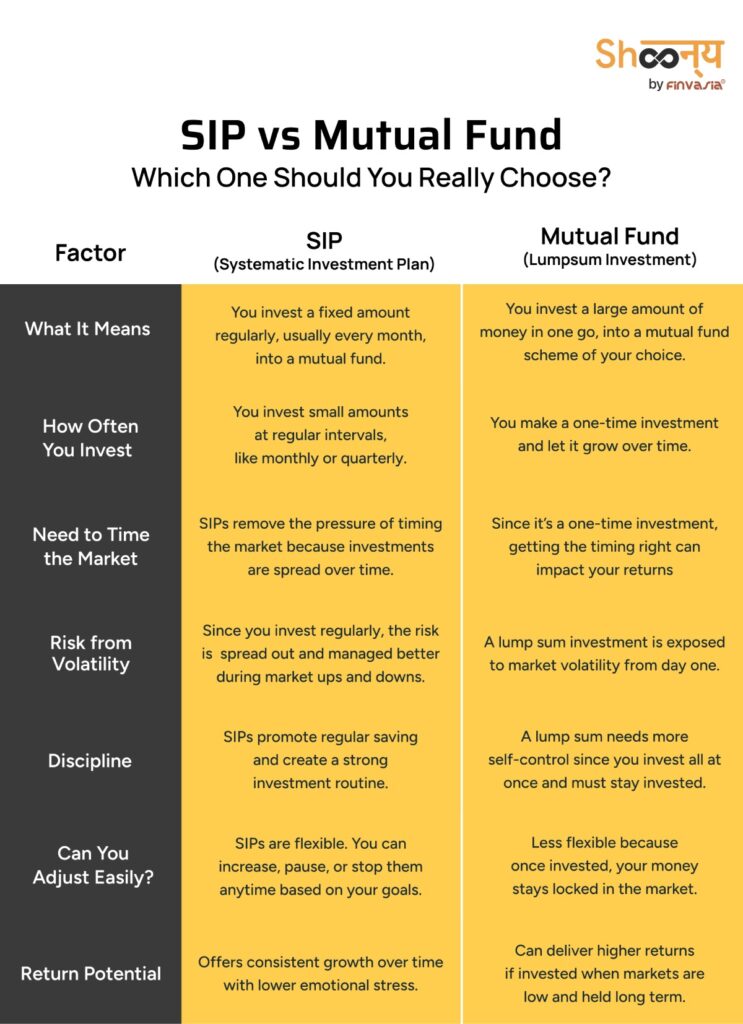Still Don’t Know the Difference Between SIP and Mutual Fund? Let’s Learn

You hear it everywhere now. During office parties, kitty parties, get-togethers or even on family WhatsApp groups:“Bas yaar, SIP chal raha hai har mahine 2000 ka.” When people say, “I invest in SIP,” what do they actually mean? The idea of investing through SIP has become common, and rightly so. More individuals today are gaining financial awareness and taking active steps toward managing their money better. They are exploring options beyond traditional savings accounts, which is a positive shift. But here’s a common misconception: SIP, or Systematic Investment Plan, is not an investment in itself. It’s simply a method, a way to invest regularly, often monthly. The actual investment being made is into a mutual fund. So, while SIP is the route, the mutual fund is the destination. What is the real difference between SIP and mutual funds?
Let’s learn!
What is a Mutual Fund?
A mutual fund is a pool of money. This pool is created when thousands of people like you, your neighbour, your cousin in Bangalore, and your school friend in Delhi all invest money into the same fund.
That money is then managed by a professional fund manager who invests it in stocks, bonds, or commodities, depending on the type of mutual fund. You get units of that fund, just like shares, based on the amount you invest and the day’s NAV (Net Asset Value).
Mutual funds are ideal for people who don’t have the time or knowledge to pick individual stocks but still want to benefit from the market. You don’t control where the money goes, but you benefit from the shared outcome. That’s how a mutual fund works.
Now, invest in stocks, bonds, mutual funds, commodities and more with a free demat account!
Types of Mutual Funds in India
There are different types of mutual funds to suit different financial goals.
- Equity Mutual Funds
These primarily invest in the stock market. They are best for long-term wealth creation and are suitable if you’re okay with short-term ups and downs.
- Debt Mutual Funds
These invest in bonds, government securities, and other fixed-income instruments. Lower risk, stable returns. Such MFs are ideal for short-term goals or risk-averse investors.
- Hybrid Mutual Funds
These invest in both equity and debt, and thus, you get a balance of growth and stability. Suitable for new investors seeking diversification.
- ELSS (Equity Linked Savings Scheme)
Tax-saving mutual funds under Section 80C and have a lock-in of 3 years and offer equity-like returns.
What is a SIP?
SIP stands for Systematic Investment Plan. It is simply a way of putting money into a mutual fund at regular intervals. Instead of investing ₹60,000 in one go, you invest ₹5,000 per month over 12 months. That money is automatically debited from your bank account and goes into your chosen mutual fund.
It’s like doing a monthly TataSky recharge. SIP is the most popular route for salaried professionals and beginners in India because it’s affordable, automated, and builds good financial habits.
Imagine choosing between:
- A ₹1,999 yearly recharge
- Or a ₹199 per month plan
Both give you calling, data, and SMS. But one is a lump sum, the other is diversified and simple.
That’s exactly the difference between lump sum and SIP in mutual funds.
Types of SIP in India
Just like mutual funds have categories, SIPs have formats too:
- Regular SIP- Fixed amount every month. The most common and widely used.
- Step-up SIP- You start with ₹2,000 and increase it every year, say by ₹500. Helps you match your rising income.
- Flexible SIP- You can change your SIP amount based on your financial situation that month. No penalty for adjusting.
- Trigger SIP- You can link your SIP to an event like NAV reaching a specific level or market correction.
Whether it’s sip mutual funds for a beginner or an experienced investor, these formats offer flexibility and discipline. When people search for the best mutual fund for SIP, they’re usually looking in these categories based on their needs and risk tolerance.

SIP vs Mutual Fund: Key Differences
Many people ask, “is SIP and mutual fund same?”
The answer is no.. Here’s the real difference between a mutual fund and an SIP:
| Basis | Mutual Fund | SIP |
| What it is | The investment product | The method of investing in that product |
| Investment style | One-time (lump sum) or recurring | Recurring (usually monthly) |
| Control over timing | You choose when and how much to invest | Fixed schedule; market timing is not required |
| Ideal for | Investors with large sums or good market knowledge | Beginners, salaried individuals, and long-term investors |
Let’s say you just got your bonus: ₹60,000. You can:
Option 1: Invest the full ₹60,000 in a mutual fund today. That’s a lump sum investment.
Option 2: Start a mutual fund SIP of ₹5,000/month in the same fund over 12 months.
Now, let’s assume the stock market fluctuates over the year. With SIP:
- In months when the market is down, you get more units.
- In months when it’s up, you get fewer units.
This averages out your cost and reduces the risk of investing at the wrong time. That’s why so many Indians prefer SIP mutual fund plans over one-time investments.
Now, which Mutual Fund Is Best for SIP?
There’s no single answer to this. But based on popularity and past performance, you have to do proper research before choosing the MF you wish to invest in!
Benefits of SIP in Mutual Funds
1. Budget-Friendly
You can start investing with just ₹500/month. For a college student or first-time earner, this is manageable and non-intimidating.
2. No Need to Time the Market
Even top investors struggle with perfect timing. SIP removes that pressure.
3. Builds Habit
Just like your rent or EMI, SIPs instil a savings habit that compounds over time.
4. Rupee Cost Averaging
This automatically adjusts your buying price over market cycles, smoothing out volatility.
5. Power of Compounding
₹2,000/month invested for 15 years at 12% returns = ₹10.5 lakh. That is how it works!
New Mutual Fund Tax Rules in 2025
Understand the real difference between SIPs and mutual funds based on how they are taxed now.
1. Equity Mutual Funds & SIPs
If you sell your equity mutual fund units or SIP investments within 12 months, the gains are considered short-term and taxed at 20%. This has increased from the earlier rate of 15%.
If you hold your investment for more than a year, it qualifies for long-term capital gains. In that case:
- You don’t pay any tax on the first ₹1.25 lakh of gains in a financial year
- Any gains above that are taxed at 12.5%
If you invest in equity mutual funds through SIPs and your total gains over the year are up to ₹3 lakh, you now pay only 5% tax on those gains. This is a big saving for long-term SIP investors. If your gains go beyond ₹3 lakh, you’ll be taxed at the standard 12.5% rate on the extra amount.
2. Debt and Hybrid Mutual Funds
Hybrid Funds (mix of equity and debt)
If your hybrid mutual fund has 35% to 65% equity, the taxation depends on how long you hold it.
- If you sell it within 2 years, gains are taxed as per your income tax slab
- If held for more than 2 years, gains are taxed at 12.5%
- Note: For investments made after April 1, 2023, indexation benefits (which reduce taxable gains) are no longer available
Debt Funds (less than 35% equity)
Debt mutual funds are now treated like fixed deposits when it comes to tax.
- No matter how long you hold them, gains are taxed as short-term
- The entire gain is added to your income and taxed as per your slab
- This rule applies to all debt mutual fund units bought after April 1, 2023
So, for salaried individuals in the 20% or 30% bracket, debt funds can be less tax-efficient unless used carefully.
3. ELSS – Tax-Saving Mutual Funds
Equity Linked Savings Schemes (ELSS) are mutual funds that give you tax benefits under Section 80C.
- You can invest up to ₹1.5 lakh per year and claim that amount as a deduction from your taxable income
- Earlier, ELSS had a 3-year lock-in period
- From 2025, the lock-in is reduced to 2 years, making it more flexible
- After this lock-in, gains are treated like equity mutual funds:
- No tax on gains up to ₹1.25 lakh
- 12.5% tax on anything above that
This makes ELSS a great option for salaried individuals.
4. Dividend Income and ITR Filing Changes
From 2025, if you earn dividends from mutual funds, you don’t need to pay tax on amounts up to ₹25,000 per year. This is a benefit for investors who prefer income-generating funds.
However, when you file your Income Tax Return (ITR), you’ll need to:
- Report short-term and long-term capital gains separately
- Clearly mention whether you’re filing under the old tax regime or the new one
Final Word: SIP is Your Companion, Mutual Fund is Your Vehicle
If you’re a working professional earning ₹60,000 a month…
If you’re a small business owner with irregular income…
If you’re planning for your child’s education 10 years later…
SIP can be your starting point.
And mutual funds? They’re the destination you pick. It could be equity for high growth, debt for safety, and a hybrid for balance. Just like you can take a train, bus, or cab to a destination, SIP is just the way to reach your goal.
Want to Start a SIP?
At Shoonya, we make investing simple.
- Zero commission on mutual funds
- Track everything in one place
SIP vs Mutual Fund- FAQs
It’s a way to invest fixed amounts regularly, monthly or quarterly, into a mutual fund scheme. You don’t have to time the market.
No. A mutual fund is the actual investment product. SIP is just a way to invest in it.
SIP is a method to invest, while a mutual fund is the actual investment. One isn’t better than the other; they work together depending on how and when you want to invest.
A ₹5,000 monthly SIP for 10 years means you’ll invest around ₹6 lakh in total. If your mutual fund gives around 12% returns annually, it could grow to over ₹11.5–12 lakh, depending on market performance.
If you invest ₹1 lakh through SIPs over time, its future value depends on the monthly amount, duration, and market returns. For example, ₹2,000/month for 4 years (₹96,000) could grow to ₹1.3–1.4 lakh at 12% annual return.
______________________________________________________________________________________
Disclaimer: Investments in the securities market are subject to market risks; read all the related documents carefully before investing.








